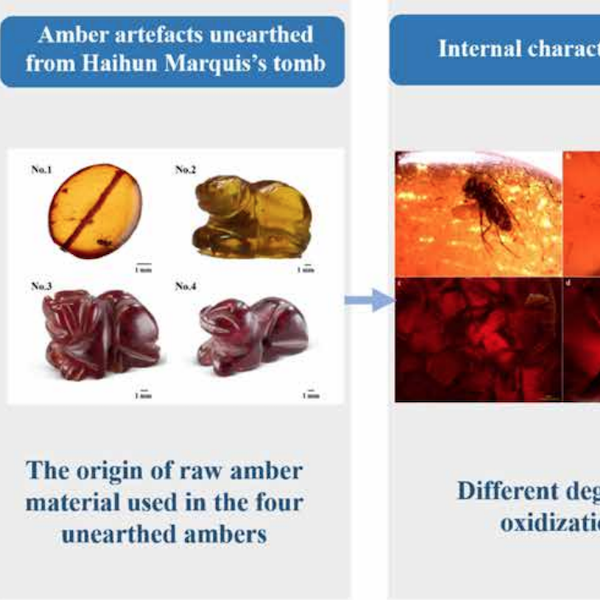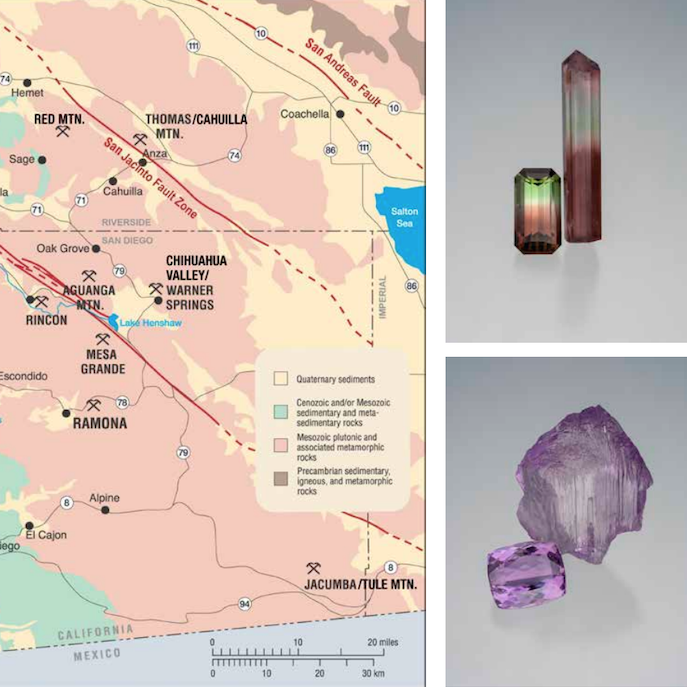Effects of weathering on FTIR spectra and origin traceability of archaeological amber: The case of the Han Tomb of Haihun Marquis, China
By Yan Li, Minghan Peng, Yamei Wang
Amber (fossil resin), known as the “capsule of time and space”, which is a complex biogenic polymer originated from ancient plants resin from different geological periods [1]. The archaeological amber artefacts inescapably undergone various degrees of weathering (typical irreversible oxidation) would change the appearance characteristics and internal compositions of amber [2], further resulting in alternations to the peak shape/position or signal noises in infrared spectra, which brings challenges in origin traceability of archaeological amber. This research [3] firstly reported a reference database of infrared fingerprint signatures of more than 113 pieces of different degrees of geological oxidised amber from Burma, Baltic region, and Fushun (China) to facilitate validation and further comparison with archaeological amber artefacts. Principal Component Analysis (PCA) and Linear Discriminant Analysis (LDA) were applied to discriminate infrared spectra data for dimensionality reduction, classification, and prediction. In this research, four cherished pieces of archaeological amber artefacts (No.1-No.4) excavated from the Haihun Marquis’ Tomb of the Western Han Dynasty were investigated as a case study to source the archaeological amber. The external and internal features of them were observed using an optical microscopy. A non-destructive analysis (attenuated total reflection Fourier-transform infrared spectroscopy [ATRFTIR]) was performed on the archaeological amber artefacts (No.1-No.4), and different degrees of geological oxidised amber reference samples. Results from the infrared spectrum of archaeological amber artefact No.2 revealed peaks at 1226, 1149, 1035, and 974 cm−1, which predominantly existed in the most Burmese amber. Archaeological amber artefacts (No.3 and No.4) displayed obvious oxidation characteristics (dark red colour, serious cracks), the FTIR peaks at 1050, 921, 553 and 476 cm−1 converged with that of the Burmese oxidised amber. However, the infrared spectrum of No.1 did not match well with the FITR spectra characteristics of Baltic, Burmese and Fushun amber. PCA was further applied to reduce the dimension of spectra data, and the 15 principal component scores with high contribution were evaluated in LDA to obtain accurate classification results and prediction results. The prediction results indicated that four archaeological amber artefacts excavated from Haihun Marquis’ Tomb were all from Burma based on the current existing detection and analysis techniques.
The archaeological amber artefacts witnessed the cultural exchange and mutual interaction on the Silk Road, and Burmese amber materials were delivered to China during the period of the Western Han Dynasty by road or via the Maritime Silk Road.

References:
- [1] Xiaopeng Su, Jing Yu, Zhaotong Shi, Yamei Wang*, Yan Li*, Headspace solid-phase microextraction comprehensive 2D gas chromatography-time of flight mass spectrometry (HS-SPME-GC × GC-TOFMS) for origin traceability of the genus Hymenaea resinites, RSC Advances, 2023, 13, 14150- 14158
- [2] XingpingLi, YameiWang, GuanghaiShi, RenLu, Yan Li*. Evaluation of natural ageing responses on Burmese amber durability by FTIR spectroscopy with PLSR and ANN models. Spectrochimica Acta Part A: Molecular and Biomolecular Spectroscopy, 2023. 285: p. 121936.
- [3] Zhao T, Peng M, Yang M, Lu R, Wang Y*, Li Y*. Effects of weathering on FTIR spectra and origin traceability of archaeological amber: The case of the Han Tomb of Haihun Marquis, China. Journal of Archaeological Science, 2023, 153(105753).
Acknowledgements:
This work has been funded by Hubei Gem & Jewelry Engineering Technology Center (No. CIGTXM-03-202104, CIGTXM-02-202001). The project was financially supported by the Fundamental Research Funds for National University, China University of Geosciences (Wuhan) (No. CUGDCJJ202221).




